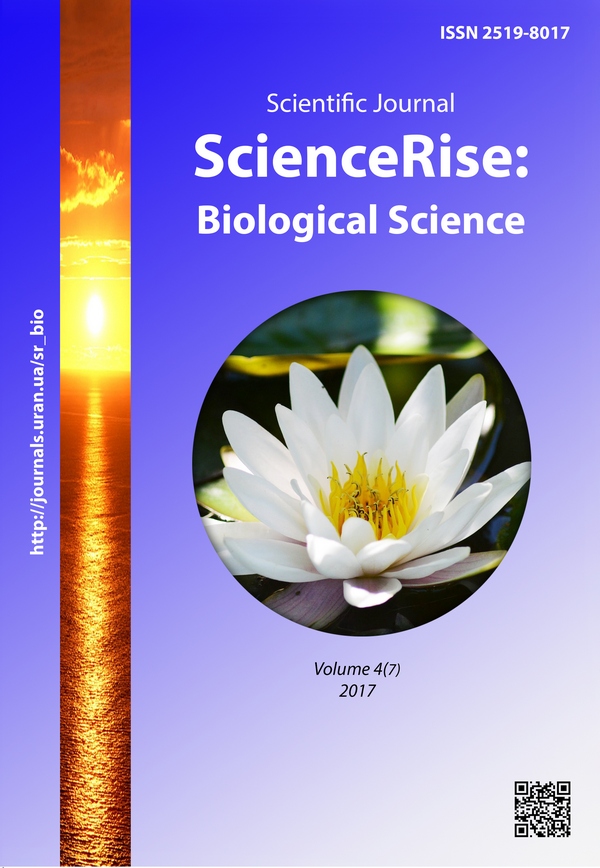Дослідження забруднення пилом повітря у виробництві продукції птахівництва
DOI:
https://doi.org/10.15587/2519-8025.2017.109220Ключові слова:
пилове забруднення, промислове птахівництво, атмосферне повітря, біоіндикація, Betula pendulaАнотація
Проведено визначення забруднення твердими суспендованими частинками. Аспіраційними методами визначено вміст твердих суспендованих частинок при різних виробничих процесах вирощування птиці. Показано значне перевищення гігієнічних нормативів. У результаті проведених досліджень встановлено дисперсійний стан пилу. Апробовано біоіндикаційний метод визначення пилу на листових пластинках дерев
Посилання
- Lonс, E., Plewa, K. (2010). Microbiological Air Contamination in Poultry Houses. Polish Journal of Environmental Studies, 19 (2), 15–19.
- Broucek, J., Cermak, B. (2015). Emission of Harmful Gases from Poultry Farms and Possibilities of Their Reduction. Ekologia, 34 (1), 89–100. doi: 10.1515/eko-2015-0010
- Keivan, M. P., Tertуchna, O. V., Keivan, O. P. (2011). Ecological monitoring of the environment in the areas of location of poultry farming enterprises. Agroecological journal, 94–95.
- Tertychna, O., Bryhas, O., Svaliavchuk, L., Miroshnik, N. (2017). Environmental assessment of the state of atmospheric air in conditions of different technologies of poultry production. ScienceRise: Biological Science, 3 (6), 18–21. doi: 10.15587/2519-8025.2017.105062
- Marchenko, O. A. (2010). Ptahivnitstvo – progresuyuchiy zabrudnyuvach atmosfernogo povitrya. Agroekologichniy zhurnal, 3, 34–38.
- Raven, P., Evert, F., Eichhorn, S. (1986). Sovremennaya botanika. Vol. 2. Moscow: Mir, 344.
- Radomskaia, M. M., Kartash, Yu. H. (2016). Otsiniuvannia rivnia pylovoho zabrudnennia atmosfernoho povitria m. Kyieva. Naukovyi visnyk NLTU, 26.4, 219–224.
- Bakhariev, V. S. (2005). Osoblyvosti formuvannia ekolohichnoi nebezpeky v umovakh pylovoho zabrudnennia atmosfernoho povitria. Biosferno-noosferni idei V. I. Vernadskoho ta ekoloho-ekonomichni problemy rozvytku rehioniv. Kremenchuk: Vyd-vo KDPU, 85–86.
- Klimenko, A. P. (1978). Metodyi i priboryi dlya izmereniya kontsentratsii pyili. Moscow: Khimiya, 208.
- Golosova, I. M. (Ed.) (1980). Sanitarno-gigienicheskie issledovaniya vozduha. Leningrad: Leningr. veterin. in-t., 63.
- Rudenko, S. S., Kostyshyn, S. S., Morozova, T. V. (2008). Zahalna ekolohiia: praktychnyi kurs. P. 1. Chernivtsi: Knyhy–XXI, 308.
##submission.downloads##
Опубліковано
Як цитувати
Номер
Розділ
Ліцензія
Авторське право (c) 2017 Olga Tertychna, Olena Bryhas, Larysa Svaliavchuk, Nataliia Miroshnik

Ця робота ліцензується відповідно до Creative Commons Attribution 4.0 International License.
Наше видання використовує положення про авторські права Creative Commons CC BY для журналів відкритого доступу.
Автори, які публікуються у цьому журналі, погоджуються з наступними умовами:
1. Автори залишають за собою право на авторство своєї роботи та передають журналу право першої публікації цієї роботи на умовах ліцензії Creative Commons CC BY, котра дозволяє іншим особам вільно розповсюджувати опубліковану роботу з обов'язковим посиланням на авторів оригінальної роботи та першу публікацію роботи у цьому журналі.
2. Автори мають право укладати самостійні додаткові угоди щодо неексклюзивного розповсюдження роботи у тому вигляді, в якому вона була опублікована цим журналом (наприклад, розміщувати роботу в електронному сховищі установи або публікувати у складі монографії), за умови збереження посилання на першу публікацію роботи у цьому журналі.










